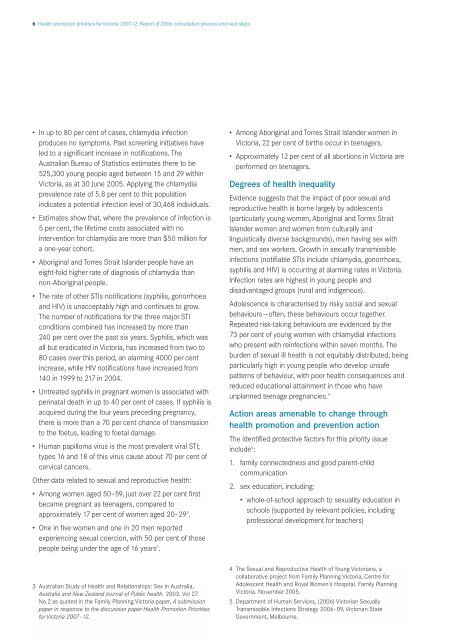Health promotion priorities for Victoria 2007–2012 - Department of ...
Health promotion priorities for Victoria 2007–2012 - Department of ...
Health promotion priorities for Victoria 2007–2012 - Department of ...
You also want an ePaper? Increase the reach of your titles
YUMPU automatically turns print PDFs into web optimized ePapers that Google loves.
6 <strong>Health</strong> <strong>promotion</strong> <strong>priorities</strong> <strong>for</strong><strong>Victoria</strong> 2007-12: Report <strong>of</strong> 2006 consultation process and next steps<br />
• In up to 80 per cent <strong>of</strong> cases, chlamydia infection<br />
produces no symptoms. Past screening initiatives have<br />
led to a significant increase in notifications. The<br />
Australian Bureau <strong>of</strong> Statistics estimates there to be<br />
525,300 young people aged between 15 and 29 within<br />
<strong>Victoria</strong>, as at 30 June 2005. Applying the chlamydia<br />
prevalence rate <strong>of</strong> 5.8 per cent to this population<br />
indicates a potential infection level <strong>of</strong> 30,468 individuals.<br />
• Estimates show that, where the prevalence <strong>of</strong> infection is<br />
5 per cent, the lifetime costs associated with no<br />
intervention <strong>for</strong> chlamydia are more than $50 million <strong>for</strong><br />
a one-year cohort.<br />
• Aboriginal and Torres Strait Islander people have an<br />
eight-fold higher rate <strong>of</strong> diagnosis <strong>of</strong> chlamydia than<br />
non-Aboriginal people.<br />
• The rate <strong>of</strong> other STIs notifications (syphilis, gonorrhoea<br />
and HIV) is unacceptably high and continues to grow.<br />
The number <strong>of</strong> notifications <strong>for</strong> the three major STI<br />
conditions combined has increased by more than<br />
240 per cent over the past six years. Syphilis, which was<br />
all but eradicated in <strong>Victoria</strong>, has increased from two to<br />
80 cases over this period, an alarming 4000 per cent<br />
increase, while HIV notifications have increased from<br />
140 in 1999 to 217 in 2004.<br />
• Untreated syphilis in pregnant women is associated with<br />
perinatal death in up to 40 per cent <strong>of</strong> cases. If syphilis is<br />
acquired during the four years preceding pregnancy,<br />
there is more than a 70 per cent chance <strong>of</strong> transmission<br />
to the foetus, leading to foetal damage.<br />
• Human papilloma virus is the most prevalent viral STI;<br />
types 16 and 18 <strong>of</strong> this virus cause about 70 per cent <strong>of</strong><br />
cervical cancers.<br />
Other data related to sexual and reproductive health:<br />
• Among women aged 50–59, just over 22 per cent first<br />
became pregnant as teenagers, compared to<br />
approximately 17 per cent <strong>of</strong> women aged 20–293 .<br />
• One in five women and one in 20 men reported<br />
experiencing sexual coercion, with 50 per cent <strong>of</strong> those<br />
people being under the age <strong>of</strong> 16 years 3 .<br />
3 Australian Study <strong>of</strong> <strong>Health</strong> and Relationships: Sex in Australia,<br />
Australia and New Zealand Journal <strong>of</strong> Public health. 2003. Vol 27.<br />
No.2 as quoted in the Family Planning <strong>Victoria</strong> paper, A submission<br />
paper in response to the discussion paper <strong>Health</strong> Promotion Priorities<br />
<strong>for</strong> <strong>Victoria</strong> 2007–12.<br />
• Among Aboriginal and Torres Strait Islander women in<br />
<strong>Victoria</strong>, 22 per cent <strong>of</strong> births occur in teenagers.<br />
• Approximately 12 per cent <strong>of</strong> all abortions in <strong>Victoria</strong> are<br />
per<strong>for</strong>med on teenagers.<br />
Degrees <strong>of</strong> health inequality<br />
Evidence suggests that the impact <strong>of</strong> poor sexual and<br />
reproductive health is borne largely by adolescents<br />
(particularly young women, Aboriginal and Torres Strait<br />
Islander women and women from culturally and<br />
linguistically diverse backgrounds), men having sex with<br />
men, and sex workers. Growth in sexually transmissible<br />
infections (notifiable STIs include chlamydia, gonorrhoea,<br />
syphilis and HIV) is occurring at alarming rates in <strong>Victoria</strong>.<br />
Infection rates are highest in young people and<br />
disadvantaged groups (rural and indigenous).<br />
Adolescence is characterised by risky social and sexual<br />
behaviours––<strong>of</strong>ten, these behaviours occur together.<br />
Repeated risk-taking behaviours are evidenced by the<br />
73 per cent <strong>of</strong> young women with chlamydial infections<br />
who present with reinfections within seven months. The<br />
burden <strong>of</strong> sexual ill health is not equitably distributed, being<br />
particularly high in young people who develop unsafe<br />
patterns <strong>of</strong> behaviour, with poor health consequences and<br />
reduced educational attainment in those who have<br />
unplanned teenage pregnancies. 4<br />
Action areas amenable to change through<br />
health <strong>promotion</strong> and prevention action<br />
The identified protective factors <strong>for</strong> this priority issue<br />
include 5 :<br />
1. family connectedness and good parent-child<br />
communication<br />
2. sex education, including:<br />
• whole-<strong>of</strong>-school approach to sexuality education in<br />
schools (supported by relevant policies, including<br />
pr<strong>of</strong>essional development <strong>for</strong> teachers)<br />
4 The Sexual and Reproductive <strong>Health</strong> <strong>of</strong> Young <strong>Victoria</strong>ns, a<br />
collaborative project from Family Planning <strong>Victoria</strong>, Centre <strong>for</strong><br />
Adolescent <strong>Health</strong> and Royal Women's Hospital. Family Planning<br />
<strong>Victoria</strong>. November 2005.<br />
5 <strong>Department</strong> <strong>of</strong> Human Services, (2006) <strong>Victoria</strong>n Sexually<br />
Transmissible Infections Strategy 2006–09, <strong>Victoria</strong>n State<br />
Government, Melbourne.

















